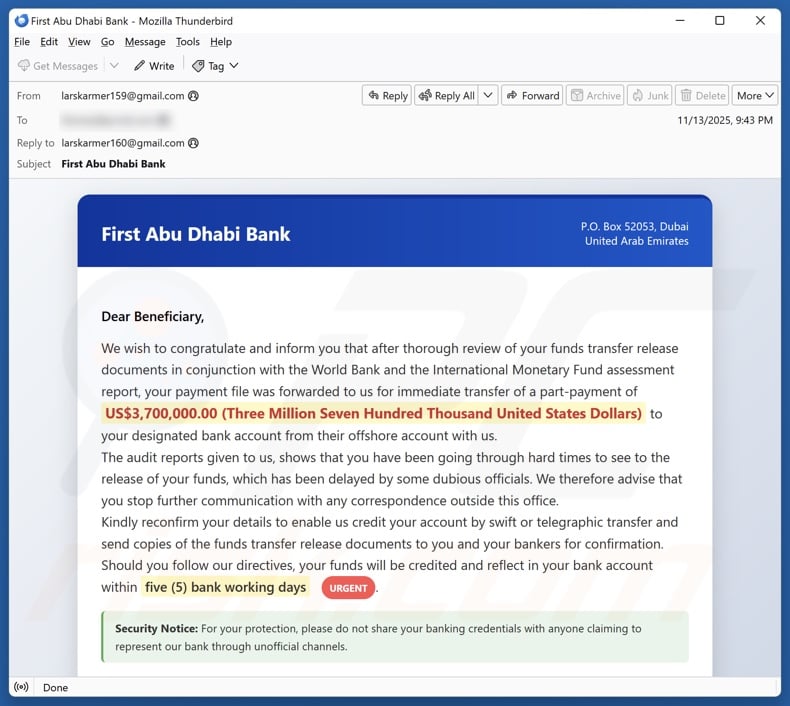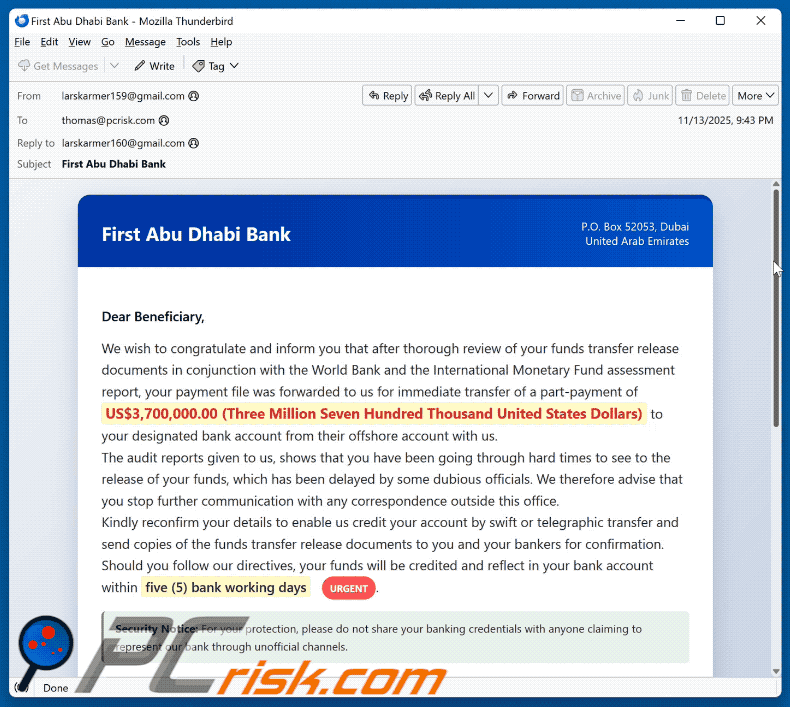How to identify fake "First Abu Dhabi Bank - Funds Transfer Documents" emails
Phishing/ScamAlso Known As: "First Abu Dhabi Bank - Funds Transfer Documents" phishing email
Get free scan and check if your device is infected.
Remove it nowTo use full-featured product, you have to purchase a license for Combo Cleaner. Seven days free trial available. Combo Cleaner is owned and operated by RCS LT, the parent company of PCRisk.com.
What kind of email is "First Abu Dhabi Bank - Funds Transfer Documents"?
After reading this "First Abu Dhabi Bank - Funds Transfer Documents" email, we determined that it is spam. It claims that the recipient's funds, which are worth over three million USD, will be transferred once the necessary information is provided. Evidently, this phishing mail targets private data, but it may also seek money directly. It must be stressed that this spam email is not associated with any legitimate entities.

"First Abu Dhabi Bank - Funds Transfer Documents" email scam overview
The spam email is presented as a missive from the First Abu Dhabi Bank. It states that, after an assessment report completed by the World Bank and the International Monetary Fund, the release of the recipient's funds has been approved. The total amount is listed as $ 3,700,000.00 USD and will be transferred to the preferred banking account.
The report indicated that the recipient has struggled with the release of their funds due to interference from suspicious officials; thus, the email advises ceasing all communication with them or others who seek it outside of the official channels. The recipient is requested to provide their information, and they are promised that their money will be released within five working days.
It must be emphasized that the claims made by this message are false, and this email is not associated with the actual First Abu Dhabi Bank (FAB), the World Bank Group (WBG), the International Monetary Fund (IMF), or any other genuine entities.
Targeted information includes: full name, age, home address, telephone number, and banking details. With this data in their possession, scammers may carry out a variety of nefarious activities, including identity theft. Stolen financial data may enable cyber criminals to carry out financial fraud, such as making unauthorized transactions and online purchases. It is noteworthy that scammers may request victims to transfer funds for legitimate-sounding reasons like paying taxes or transaction fees.
If you have already disclosed your personally identifiable or finance-related data to cyber criminals – immediately contact the appropriate authorities.
| Name | "First Abu Dhabi Bank - Funds Transfer Documents" phishing email |
| Threat Type | Phishing, Scam, Social Engineering, Fraud |
| Fake Claim | Recipient is asked to provide their details to facilitate the transfer of $3,700,000 to their bank account. |
| Disguise | First Abu Dhabi Bank (FAB) |
| Symptoms | Unauthorized online purchases, changed online account passwords, identity theft, illegal access of the computer. |
| Distribution methods | Deceptive emails, rogue online pop-up ads, search engine poisoning techniques, misspelled domains. |
| Damage | Loss of sensitive private information, monetary loss, identity theft. |
| Malware Removal (Windows) |
To eliminate possible malware infections, scan your computer with legitimate antivirus software. Our security researchers recommend using Combo Cleaner. Download Combo CleanerTo use full-featured product, you have to purchase a license for Combo Cleaner. 7 days free trial available. Combo Cleaner is owned and operated by RCS LT, the parent company of PCRisk.com. |
Phishing spam campaign examples
"Internal Error", "Bill Holdings - Initiated Payment", "Island Bargains Packages Ready For Pickup", "Incoming Message Paused", and "Wix Subscription Expiration" are merely some of our newest articles on phishing emails.
These messages predominantly target personally identifiable information, finance-related data, and account log-in credentials (e.g., emails, social networking, social media, messengers, entertainment, e-commerce, online banking, cryptowallets, etc.). Various scams are promoted through spam mail. It is also used to distribute all kinds of malware.
Due to how prevalent this mail is and how well-made it can be – we highly recommend exercising caution with incoming emails, DMs/PMs, SMSes, and other messages.
How do spam campaigns infect computers?
Malware is often proliferated via spam campaigns (malspam). These spam emails/messages include virulent files as attachments or download links. They can be documents (Microsoft Office, Microsoft OneNote, PDF, etc.), executables (.exe, .run, etc.), archives (ZIP, RAR, etc.), JavaScript, and so on.
Malware is downloaded/installed when a file of this kind is opened. However, some formats require additional interaction to initiate infection processes. For example, Microsoft Office files need users to enable macro commands (i.e., editing/content), while OneNote documents require them to click embedded links or files.
How to avoid installation of malware?
We advise vigilance with incoming emails and other messages. Attachments or links found in suspicious communications must not be opened, as they can be deceptive or spread malware.
It must be mentioned that malicious software is not distributed only through spam campaigns. Therefore, we recommend being cautious while browsing, as the Internet is rife with fake and dangerous content.
Additionally, all downloads must be performed from official and verified sources. Another recommendation is to activate and update programs using functions/tools provided by legitimate developers, as illegal product activation tools ("cracks") and third-party updates may contain malware.
It is essential for device/user safety to have a reputable antivirus installed and kept updated. Security software must be used to perform regular system scans and to remove detected threats. If you've already opened malicious attachments, we recommend running a scan with Combo Cleaner Antivirus for Windows to automatically eliminate infiltrated malware.
Text presented in the "First Abu Dhabi Bank - Funds Transfer Documents" spam email letter:
Subject: First Abu Dhabi Bank
First Abu Dhabi Bank
P.O. Box 52053, Dubai
United Arab EmiratesDear Beneficiary,
We wish to congratulate and inform you that after thorough review of your funds transfer release documents in conjunction with the World Bank and the International Monetary Fund assessment report, your payment file was forwarded to us for immediate transfer of a part-payment of US$3,700,000.00 (Three Million Seven Hundred Thousand United States Dollars) to your designated bank account from their offshore account with us.
The audit reports given to us, shows that you have been going through hard times to see to the release of your funds, which has been delayed by some dubious officials. We therefore advise that you stop further communication with any correspondence outside this office.
Kindly reconfirm your details to enable us credit your account by swift or telegraphic transfer and send copies of the funds transfer release documents to you and your bankers for confirmation.
Should you follow our directives, your funds will be credited and reflect in your bank account within five (5) bank working days URGENT.Security Notice: For your protection, please do not share your banking credentials with anyone claiming to represent our bank through unofficial channels.
For further details and assistance on this Remittance Notification, kindly provide us with the below details:
FULL NAME AND AGE:
BANKING DETAILS:
TELEPHONE NUMBER:
FULL CONTACT ADDRESS:
CHRIS Jauques
Group Chief Risk Officer
First Abu Dhabi Bank PJSC
Dubai, United Arab EmiratesEmail: larskarmer161@gmail.com
This communication is confidential and intended solely for the addressee. If you are not the intended recipient, please delete this message and notify the sender immediately.
Appearance of the "First Abu Dhabi Bank - Funds Transfer Documents" spam email (GIF):

Instant automatic malware removal:
Manual threat removal might be a lengthy and complicated process that requires advanced IT skills. Combo Cleaner is a professional automatic malware removal tool that is recommended to get rid of malware. Download it by clicking the button below:
DOWNLOAD Combo CleanerBy downloading any software listed on this website you agree to our Privacy Policy and Terms of Use. To use full-featured product, you have to purchase a license for Combo Cleaner. 7 days free trial available. Combo Cleaner is owned and operated by RCS LT, the parent company of PCRisk.com.
Quick menu:
- What is "First Abu Dhabi Bank - Funds Transfer Documents" phishing email?
- Types of malicious emails.
- How to spot a malicious email?
- What to do if you fell for an email scam?
Types of malicious emails:
![]() Phishing Emails
Phishing Emails
Most commonly, cybercriminals use deceptive emails to trick Internet users into giving away their sensitive private information, for example, login information for various online services, email accounts, or online banking information.
Such attacks are called phishing. In a phishing attack, cybercriminals usually send an email message with some popular service logo (for example, Microsoft, DHL, Amazon, Netflix), create urgency (wrong shipping address, expired password, etc.), and place a link which they hope their potential victims will click on.
After clicking the link presented in such email message, victims are redirected to a fake website that looks identical or extremely similar to the original one. Victims are then asked to enter their password, credit card details, or some other information that gets stolen by cybercriminals.
![]() Emails with Malicious Attachments
Emails with Malicious Attachments
Another popular attack vector is email spam with malicious attachments that infect users' computers with malware. Malicious attachments usually carry trojans that are capable of stealing passwords, banking information, and other sensitive information.
In such attacks, cybercriminals' main goal is to trick their potential victims into opening an infected email attachment. To achieve this goal, email messages usually talk about recently received invoices, faxes, or voice messages.
If a potential victim falls for the lure and opens the attachment, their computers get infected, and cybercriminals can collect a lot of sensitive information.
While it's a more complicated method to steal personal information (spam filters and antivirus programs usually detect such attempts), if successful, cybercriminals can get a much wider array of data and can collect information for a long period of time.
![]() Sextortion Emails
Sextortion Emails
This is a type of phishing. In this case, users receive an email claiming that a cybercriminal could access the webcam of the potential victim and has a video recording of one's masturbation.
To get rid of the video, victims are asked to pay a ransom (usually using Bitcoin or another cryptocurrency). Nevertheless, all of these claims are false - users who receive such emails should ignore and delete them.
How to spot a malicious email?
While cyber criminals try to make their lure emails look trustworthy, here are some things that you should look for when trying to spot a phishing email:
- Check the sender's ("from") email address: Hover your mouse over the "from" address and check if it's legitimate. For example, if you received an email from Microsoft, be sure to check if the email address is @microsoft.com and not something suspicious like @m1crosoft.com, @microsfot.com, @account-security-noreply.com, etc.
- Check for generic greetings: If the greeting in the email is "Dear user", "Dear @youremail.com", "Dear valued customer", this should raise suspiciousness. Most commonly, companies call you by your name. Lack of this information could signal a phishing attempt.
- Check the links in the email: Hover your mouse over the link presented in the email, if the link that appears seems suspicious, don't click it. For example, if you received an email from Microsoft and the link in the email shows that it will go to firebasestorage.googleapis.com/v0... you shouldn't trust it. It's best not to click any links in the emails but to visit the company website that sent you the email in the first place.
- Don't blindly trust email attachments: Most commonly, legitimate companies will ask you to log in to their website and to view any documents there; if you received an email with an attachment, it's a good idea to scan it with an antivirus application. Infected email attachments are a common attack vector used by cybercriminals.
To minimise the risk of opening phishing and malicious emails we recommend using Combo Cleaner Antivirus for Windows.
Example of a spam email:

What to do if you fell for an email scam?
- If you clicked on a link in a phishing email and entered your password - be sure to change your password as soon as possible. Usually, cybercriminals collect stolen credentials and then sell them to other groups that use them for malicious purposes. If you change your password in a timely manner, there's a chance that criminals won't have enough time to do any damage.
- If you entered your credit card information - contact your bank as soon as possible and explain the situation. There's a good chance that you will need to cancel your compromised credit card and get a new one.
- If you see any signs of identity theft - you should immediately contact the Federal Trade Commission. This institution will collect information about your situation and create a personal recovery plan.
- If you opened a malicious attachment - your computer is probably infected, you should scan it with a reputable antivirus application. For this purpose, we recommend using Combo Cleaner Antivirus for Windows.
- Help other Internet users - report phishing emails to Anti-Phishing Working Group, FBI’s Internet Crime Complaint Center, National Fraud Information Center and U.S. Department of Justice.
Frequently Asked Questions (FAQ)
Why did I receive this email?
Spam emails are not personal, even if they contain information of such nature. Thousands of users receive identical (or incredibly similar) emails because they are distributed in large-scale operations.
I have provided my personal information when tricked by this spam email, what should I do?
If you have disclosed personally identifiable or finance-related information (e.g., ID card details, passport scans/photos, credit/debit card numbers, etc.) – immediately contact the appropriate authorities. However, if you've provided your log-in credentials – change the passwords of all potentially compromised accounts and inform their official support without delay.
I have read a spam email but didn't open the attachment, is my computer infected?
No, reading an email does not pose an infection threat. Devices are infected when malicious attachments or links are opened/clicked.
I have downloaded and opened a file attached to a spam email, is my computer infected?
File formats may influence infection success rates. If the file was an execution – most likely, yes – the system was infected. However, you might have avoided this if it was a document. These formats may require extra interaction (e.g., enabling macros, clicking embedded links/files, etc.) to jumpstart infection processes.
Will Combo Cleaner remove malware infections present in email attachments?
Yes, Combo Cleaner can detect and remove most of the known malware infections. Remember that performing a full system scan is essential since sophisticated malicious software usually hides deep within systems.
Share:

Tomas Meskauskas
Expert security researcher, professional malware analyst
I am passionate about computer security and technology. I have an experience of over 10 years working in various companies related to computer technical issue solving and Internet security. I have been working as an author and editor for pcrisk.com since 2010. Follow me on Twitter and LinkedIn to stay informed about the latest online security threats.
PCrisk security portal is brought by a company RCS LT.
Joined forces of security researchers help educate computer users about the latest online security threats. More information about the company RCS LT.
Our malware removal guides are free. However, if you want to support us you can send us a donation.
DonatePCrisk security portal is brought by a company RCS LT.
Joined forces of security researchers help educate computer users about the latest online security threats. More information about the company RCS LT.
Our malware removal guides are free. However, if you want to support us you can send us a donation.
Donate
▼ Show Discussion